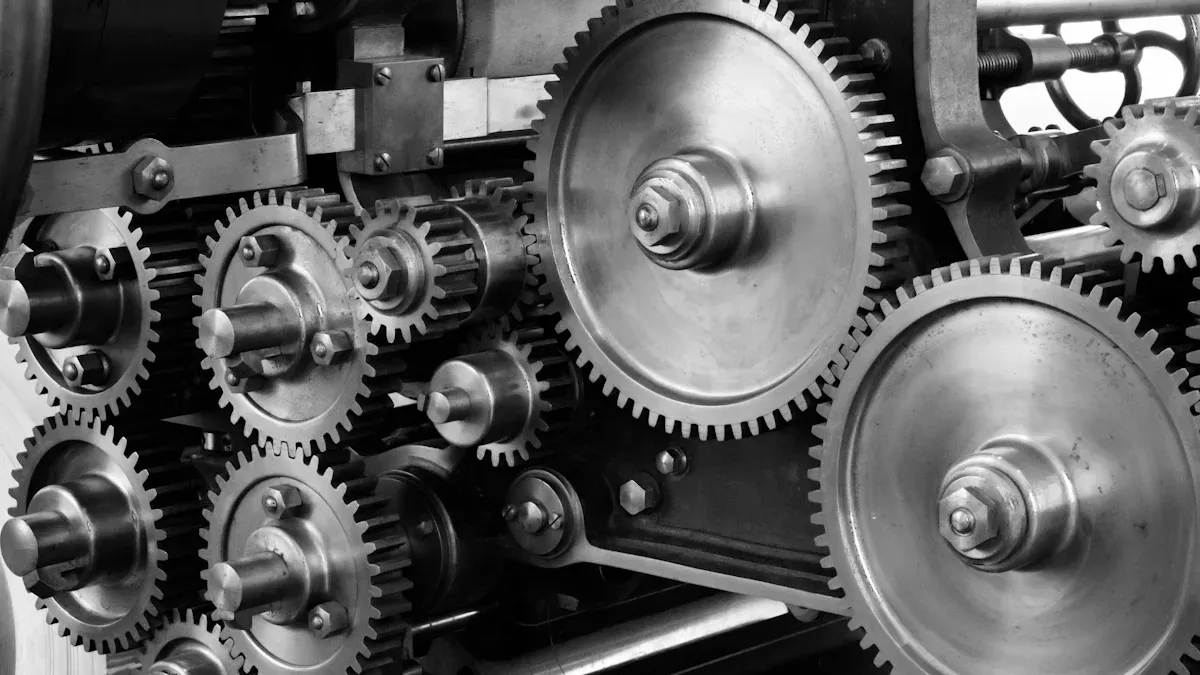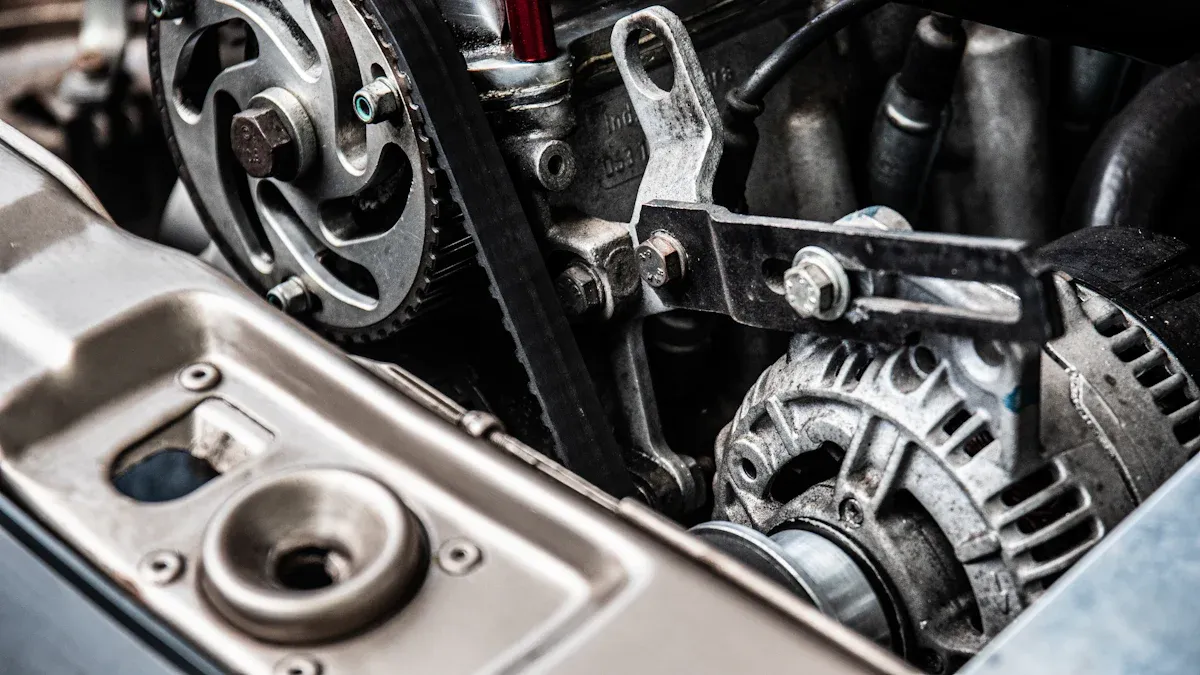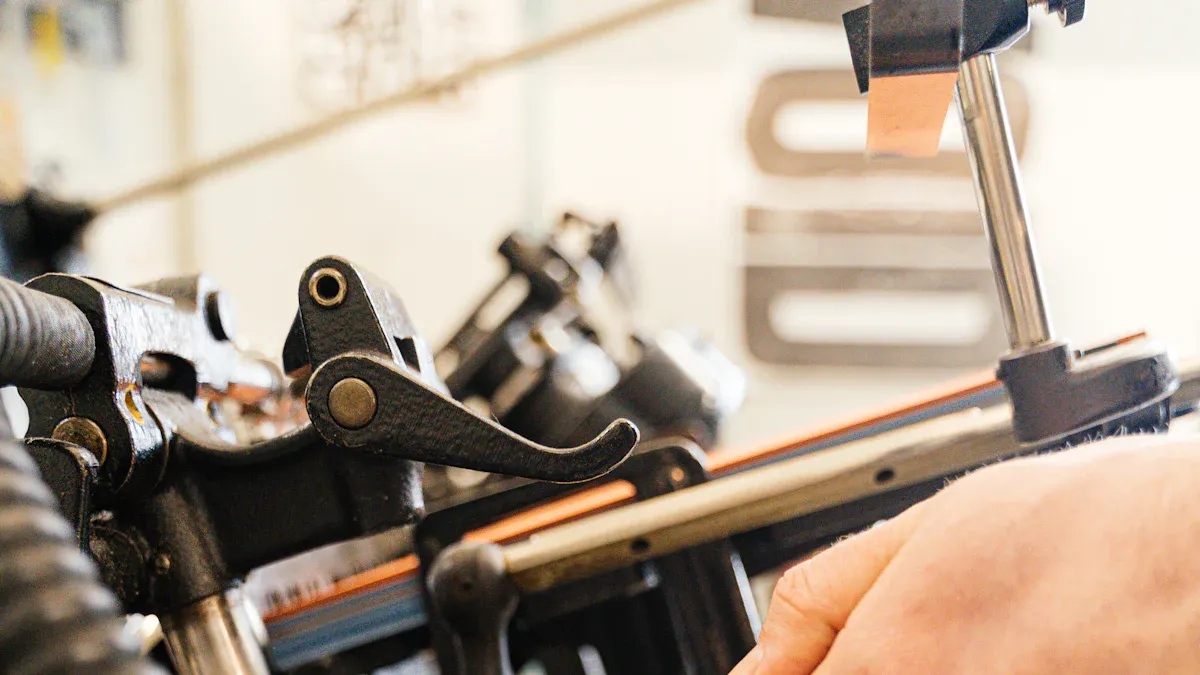
Custom wear parts are essential components designed to improve the performance and durability of machinery. These parts are crafted to meet specific operational needs, ensuring a precise fit and long-lasting functionality. When you source them from trusted manufacturers , they deliver unmatched reliability and consistency. This reliability directly reduces downtime and enhances cost efficiency.
For instance, optimizing designs and streamlini ng manufacturing processes can lower production costs without sacrificing quality. By focusing on these improvements, you enhance machinery efficiency while keeping expenses under control.

Custom wear parts are designed to withstand the toughest conditions, ensuring your machinery operates efficiently for longer periods. By using high-quality materials and advanced manufacturing techniques, these parts deliver exceptional durability. For example:
- In the metal machining industry, a company reduced tool change frequency by 50% and increased production uptime by 30%, saving over $100,000 annually.
- A construction machinery manufacturer achieved a 40% decrease in maintenance costs and extended tool lifespan by 25% after switching to tungsten carbide wear parts.
Reliability testing further supports these claims. Parts made from solid metal avoid issues like porosity, which enhances their strength. Materials like stainless steel resist corrosion, while aluminum offers a high strength-to-weight ratio. Rigorous testing methods, such as accelerated life testing and thermal-induced shock simulations, ensure these parts perform under real-world conditions.
By investing in durable custom wear parts, you minimize the need for frequent replacements, reducing downtime and maintenance costs.
One of the greatest advantages of custom wear parts is their ability to meet the unique demands of your machinery. Unlike generic components, these parts are engineered to fit perfectly and optimize performance. For instance:
| Feature | Benefit |
|---|---|
| Custom-formulated urethane tailored to specific performance criteria | Enhances longevity and reduces maintenance compared to standard rubber components. |
| Urethane's chemical structure modified for various characteristics | Provides versatility to meet diverse application needs. |
| Modular rotor and tool systems designed for specific materials | Improves efficiency and extends the lifespan of wear parts. |
| Innovative designs for shredder components | Optimizes productivity and minimizes downtime. |
Custom solutions also provide higher accuracy than general-purpose parts. This precision reduces wear and tear, streamlines production, and improves overall equipment efficiency. By choosing tail ored components, you ensure your machinery operates at its best, even in challenging environments.
While custom wear parts may have a higher upfront cost, they offer significant savings in the long run. Their durability reduces the frequency of replacements, cutting down on maintenance expenses. Tailored designs also improve operational efficiency, which lowers energy consumption and boosts productivity.
Optimized machines equipped with these parts streamline production processes, helping you save on labor and material costs. For example, urethane components last longer in harsh environments, reducing the need for frequent replacements. Similarly, modular systems allow you to adjust configurations for different processing requirements, ensuring you get the most out of your investment.
By prioritizing quality and customization, you not only enhance your machinery's performance but also achieve better cost-efficiency over time.
When selecting custom wear parts, you need to evaluate several critical factors to ensure reliability and performance. These factors help you make informed decisions and avoid costly mistakes.
Dimensional Accuracy: Parts must fit precisely into your machinery. Poorly fitting components can cause inefficiencies and damage.
Material Strength: Strong materials, such as those with high tensile and yield strength, withstand operational stresses without breaking.
Surface Finish: A smooth surface improves functionality and reduces wear. It also enhances the part's appearance.
| Metric | Description |
|---|---|
| Dimensional Accuracy | The degree to which stamped parts conform to specified dimensions, crucial for precise fit in applications. |
| Material Strength | Metrics like tensile and yield strength assess a material's ability to withstand operational stresses without failure. |
| Surface Finish | Refers to the quality of a part's surface, impacting functionality and aesthetic appeal, including texture and smoothness. |
Certifications also play a vital role in ensuring quality. Look for standards like AS9100 for aerospace or ISO 13485 for medical devices. These cert ifications guarantee that the parts meet strict industry requirements.
Partnering with a reliable manufacturer ensures you receive high-quality custom wear parts. Trusted manufacturers follow rigorous quality control processes and adhere to industry standards. Certifications like AS9110 demonstrate their commitment to safety and reliability.
When evaluating a manufacturer, consider their experienc e and expertise. Manufacturers with a proven track record understand the unique challenges of your industry. They can recommend the best materials and designs for your specific needs.
Additionally, ask about their testing methods. Reliable manufacturers use metrics like Mean Time Between Failure (MTBF) and Mean Time to Failure (MTTF) to assess the durability of their products. These metrics provide valuable insights into how long the parts will last under real-world conditions.
| Metric | Description |
|---|---|
| Mean Time Between Failure | Measures the average time between equipment failures, indicating the reliability of production assets. |
| Mean Time to Failure | Similar to MTBF, but for non-repairable components, showing how long they last before needing replacement. |
| Unscheduled Downtime | Indicates the duration equipment is unable to perform due to reliability issues, impacting revenue. |
Customer reviews and case studies offer valuable insights into the performance of custom wear parts. Reviews highlight real-world experiences, helping you identify potential issues or benefits. Look for patterns in feedback, such as consistent praise for durability or concerns about fit.
Case studies provide detailed examples of how custom wear parts have solved specific problems. For instance, a case study might show how a company reduced unscheduled downtime by 30% after switching to high-quality parts. These success stories demonstrate the tangible benefits of investing in reliable components.
When reviewing feedback, focus on metrics like Failures In Time (FIT) and Parts Per Million (PPM). These benchmarks validate the reliability of the parts and the manufacturer's quality control processes.
| Metric | Description |
|---|---|
| Failures In Time (FIT) | Number of failures per billion hours, indicating reliability over time. |
| Parts Per Million (PPM) | A measure of the number of defective parts per million produced, reflecting quality control. |
| BX-life | The lifespan at which a certain percentage of products are expected to fail, providing insight into durability. |
By considering these factors, you can confidently choose custom wear parts that meet your needs and deliver long-term value.

Custom wear parts play a vital role in improving machinery performance across various industries. These parts enhance durability, reduce downtime, and optimize operational efficiency. Some sectors benefit significantly from their implementation:
| Sector | Performance Improvement Description |
|---|---|
| Construction | Significant performance improvements due to enhanced equipment durability, performance, and safety, minimizing downtime and costs. |
| Manufacturing | Increased productivity through tailored components that reduce wear and tear on machinery. |
| Mining | Improved equipment lifespan and reduced maintenance costs in harsh operating enviro nments. |
| Agriculture | Enhanced machinery efficiency for planting, harvesting, and processing crops. |
In construction, for example, custom wear parts ensure equipment operates reliably under demanding conditions. This reliability minimizes costly delays and boosts safety for workers. Similarly, mining operations benefit from parts designed to withstand abrasive materials, extending the lifespan of critical machinery.
Custom wear parts come in many forms, each tailored to specific applications. These parts improve functionality and address unique challenges in various industries. Here are some examples:
| Custom Wear Part | Description |
|---|---|
| Custom-Molded Shoes | Constructed over a positive model of the patient’s foot, made from quality materials, and adjustable. |
| Depth Shoes | Designed with a filler for additional depth, made from quality materials, and available in various sizes. |
| External Breast Pr ostheses | Custom-fabricated forms and bras for breast restoration. |
| Facial Prostheses | Custom-fabricated prosthetic restorations for various facial areas affected by injury or disease. |
| Inserts | Total contact, multiple density, removable inlays molded to the patient’s foot. |
| Ocular Prostheses | Custom-fabricated prostheses for eye restoration due to injury or congenital issues. |
| Orthotic Devices | Rigid and semi-rigid devices for support or motion restriction of body parts. |
For industrial applications, modular rotor systems and shredder components are common examples. These parts improve efficiency and reduce wear, ensuring machinery operates at peak performance. In healthcare, prosthetic devices and inserts demonstrate how customization meets individual needs, enhancing comfort and functionality.
Custom wear parts provide solutions tailored to specific challenges, whether in construction, manufacturing, or healthcare. By investing in these components, you ensure your equipment or devices deliver reliable performance over time.
Custom wear parts offer unmatched benefits for your machinery. Their durability ensures longer operational life, while tailored designs optimize performance for specific applications. These advantages translate int o significant cost savings over time.
Selecting a trusted manufacturer is critical to achieving these benefits. Reliable suppliers consistently deliver high-quality parts that meet performance and durability standards. Studies confirm that evaluating a supplier’s quality control processes and reliability capabilities can give you a competitive edge. This upfront effort ensures your machinery operates efficiently and minimizes downtime.
For the best results, consult experts or manufacturers who understand your unique needs. Their guidance will help you choose the right components to maximize your equipment's potential.
Custom wear parts are crafted from materials like tungsten carbide, stainless steel, or urethane. These materials resist wear and tear, ensuring durability. Manufacturers select the material based on your machinery's specific needs and operating conditions.
Custom wear parts fit your machinery perfectly, minimizing inefficiencies. Their durability reduces the frequency of replacements. This combination ensures your equipment operates smoothly, cutting down on unexpected downtime.
Yes, they are. While the initial cost may be higher, their longevity and tailored fit reduce maintenance expenses. Over time, you save money by avoiding frequent replacements and improving operational efficiency.
Absolutely! Industries like construction, mining, manufacturing, and agriculture benefit the most. Custom wear parts are designed to meet the unique challenges of each sector, ensuring optimal performance in diverse environments.
Look for manufacturers with certifications like ISO 9001. Check their experience in your industry. Read customer reviews and case studies to evaluate their reliability. Trusted manufacturers also provide detailed testing data to ensure quality.
💡 Tip: Always consult with experts to determine the best custom wear parts for your specific needs.